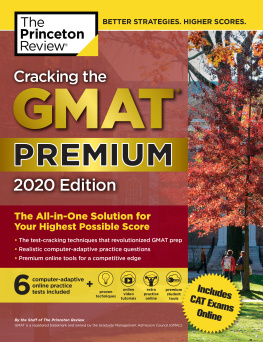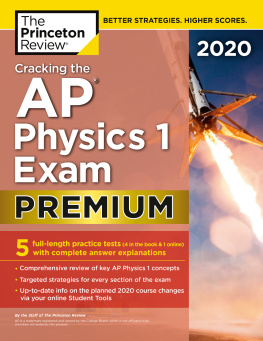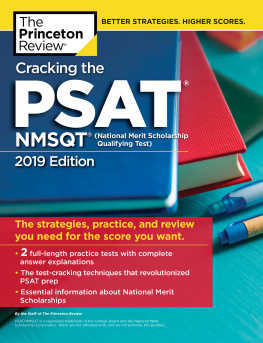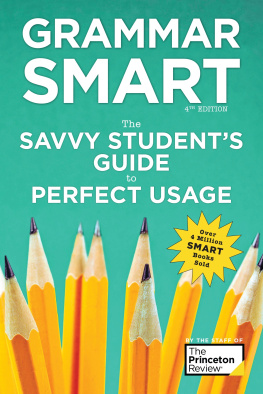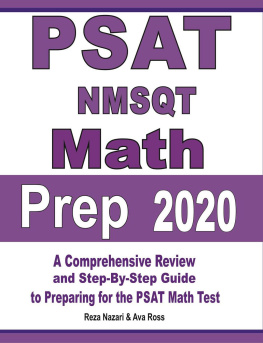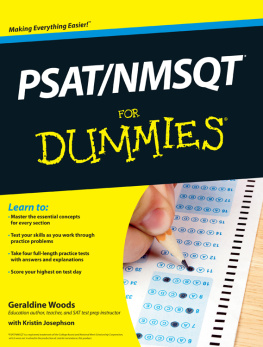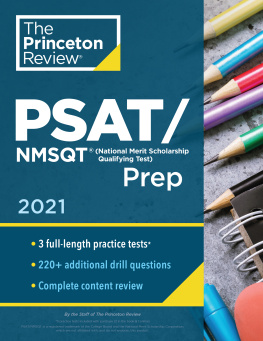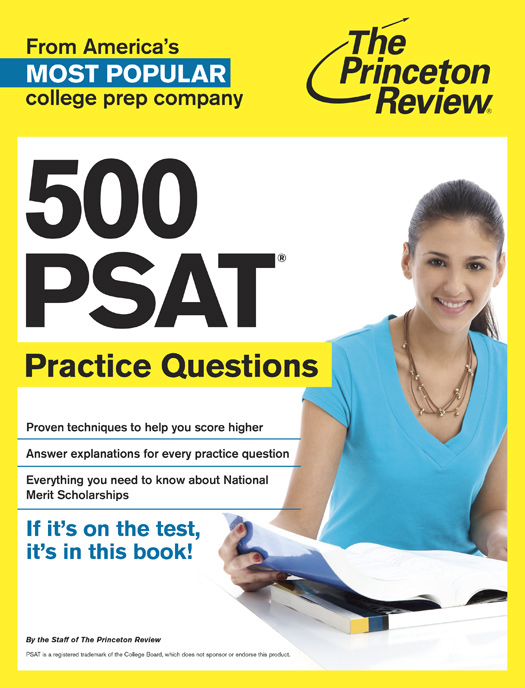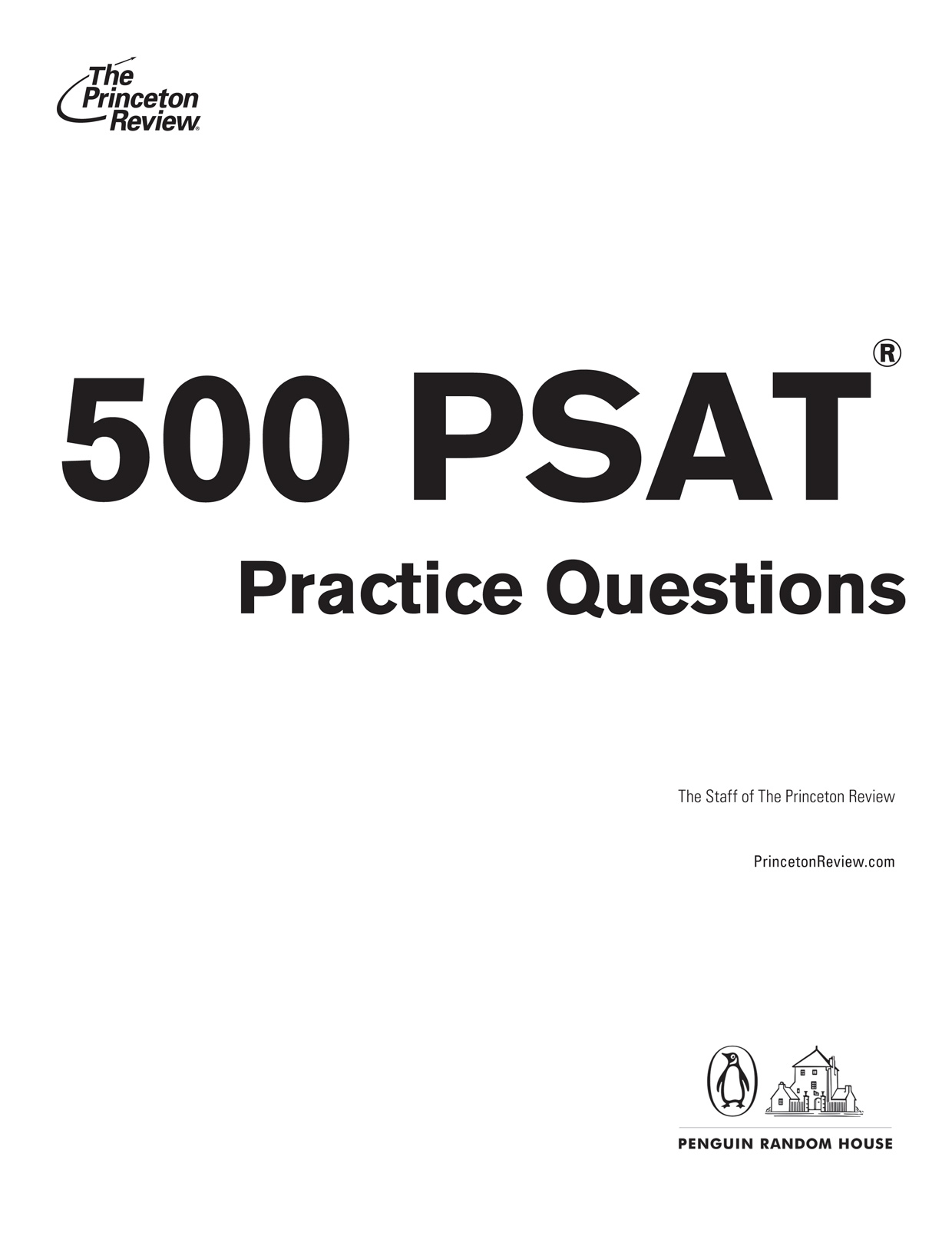Editorial
Rob Franek, Senior VP, Publisher
Casey Cornelius, VP Content Development
Mary Beth Garrick, Director of Production
Selena Coppock, Managing Editor
Kristen OToole, Editorial Director
Calvin Cato, Editor
Meave Shelton, Editor
Alyssa Wolff, Editorial Assistant
Random House Publishing Team
Tom Russell, Publisher
Alison Stoltzfus, Publishing Manager
Dawn Ryan, Associate Managing Editor
Ellen Reed, Production Manager
Erika Pepe, Associate Production Manager
Kristin Lindner, Production Supervisor
Andrea Lau, Designer
The Princeton Review
24 Prime Parkway, Suite 201
Natick, MA 01760
E-mail:
Copyright 2014 by TPR Education IP Holdings, LLC. All rights reserved.
Cover art Jonathan Pozniak
Published in the United States by Random House, LLC, New York, and simultaneously in Canada by Random House of Canada Limited, Toronto.
A Penguin Random House Company.
eBook ISBN: 978-0-8041-2485-0
Print ISBN: 978-0-8041-2484-3
PSAT is a registered trademark of the College Board, which does not sponsor or endorse this product.
The Princeton Review is not affiliated with Princeton University.
Editor: Aaron Riccio
Production Editor: Beth Hanson
Production Artist: Deborah A. Silvestrini
v3.1
Acknowledgments
This book could never have been created without the dedication and collective expertise of the staff and students of The Princeton Review.
Many thanks to Jonathan Chiu, the National Content Director for High School Programs.
Many thanks also to Chris Aylward, Brian Becker, Lisa Mayo, Amy Minster, Elizabeth Owens, and Stephen Shuck for their contributions in developing the content for this title.
Special thanks to Claudia Landgrover for masterfully managing the development and review processes for this title.
Special thanks also to Adam Robinson, who conceived of and perfected the Joe Bloggs approach to standardized tests as well as many other successful techniques used by The Princeton Review.
Contents
So Much More Online!
More Practice
- Free SAT online demonstration with a full-length practice SAT and interactive lessons
More Good Stuff
- PSAT at-a-glance overview
- Articles on SAT techniques to get you ready for the next step
then College!
- Detailed profiles for hundreds of colleges help you find the school that is right for you
- Dozens of Top 10 ranking lists including Quality of Professors, Worst Campus Food, Most Beautiful Campus, Party Schools, Diverse Student Population, and tons more
- Useful information about the admissions process
- Helpful information about financial aid and scholarships
Chapter 1
Introduction
Who Writes the PSAT?
The PSAT is written and administered by Educational Testing Service (ETS), under contract by the College Board. You might think that the people at ETS are educators, professors of education, or teachers. They are not. The people who work for ETS are average people who just happen to make a living writing tests. In fact, they write hundreds of tests, for all kinds of organizations. They are a group of testers-for-hire who will write a test for anyone who asks.
The folks at ETS are not paid to educate; they are paid to write and administer tests. Furthermore, even though you will be paying ETS to take the PSAT, you are not their customer. The actual customers ETS caters to are the colleges, who get the information they want at no cost. This means that you should take everything that ETS says with a grain of salt and realize that its testing advice is not always the best advice. (Getting testing advice from ETS is a bit like getting baseball advice from the opposing team.)
Every test reflects the interests of the people who write it. If you know who writes the test, you will know a lot more about what kinds of answers will be considered correct answers on that test.
What Is The Princeton Review?
The Princeton Review is the nations leading test-preparation company. In just a few years, we became the nations leader in SAT preparation, primarily because our techniques work. We offer courses and private tutoring for all of the major standardized tests, and we publish a series of books to help in your search for the right school. If you would like more information about how The Princeton Review can help you, go to PrincetonReview.com or call 800-2-Review.
Shortcuts
The Princeton Reviews
techniques are the closest
thing there is to a shortcut
to the PSAT. However,
there is no shortcut to
learning these techniques.
How to Use this Book
This book is divided into three main parts. The first part of the book is a practice test that will give you an idea of your strengths and weaknesses, both of which can be sources of improvement. If youre already good at something, additional practice can make you great at it; if youre not so good at something, what you should do about it depends on how important it is.
The second part of the book contains the different sections of a full-length PSAT so that you can practice on timing or content or both! Focus on the problems that gave you trouble in the first test in this book. If you ultimately decide that you would like more practice, our Cracking the PSAT edition can give the additional work that you seek.
The third part of the book contains two additional full-length PSATs for you to use for evaluative purposes.
When You Take a Practice Test
Here are some guidelines for taking these tests:
- Time yourself strictly. Use a timer, watch, or stopwatch that will ring, and do not allow yourself to go over time for any section. If you try to do so at the real test, your scores will likely be canceled.
- Take a practice test in one sitting, allowing yourself breaks of no more than two minutes between sections. You need to build up your endurance for the real test, and you also need an accurate picture of how well you will do.
- Always take a practice test using an answer sheet with bubbles to fill in, just as you will for the real test. For the practice tests in the book, use the attached answer sheets. You need to be comfortable transferring answers to the separate sheet because you will be skipping around a bit.


